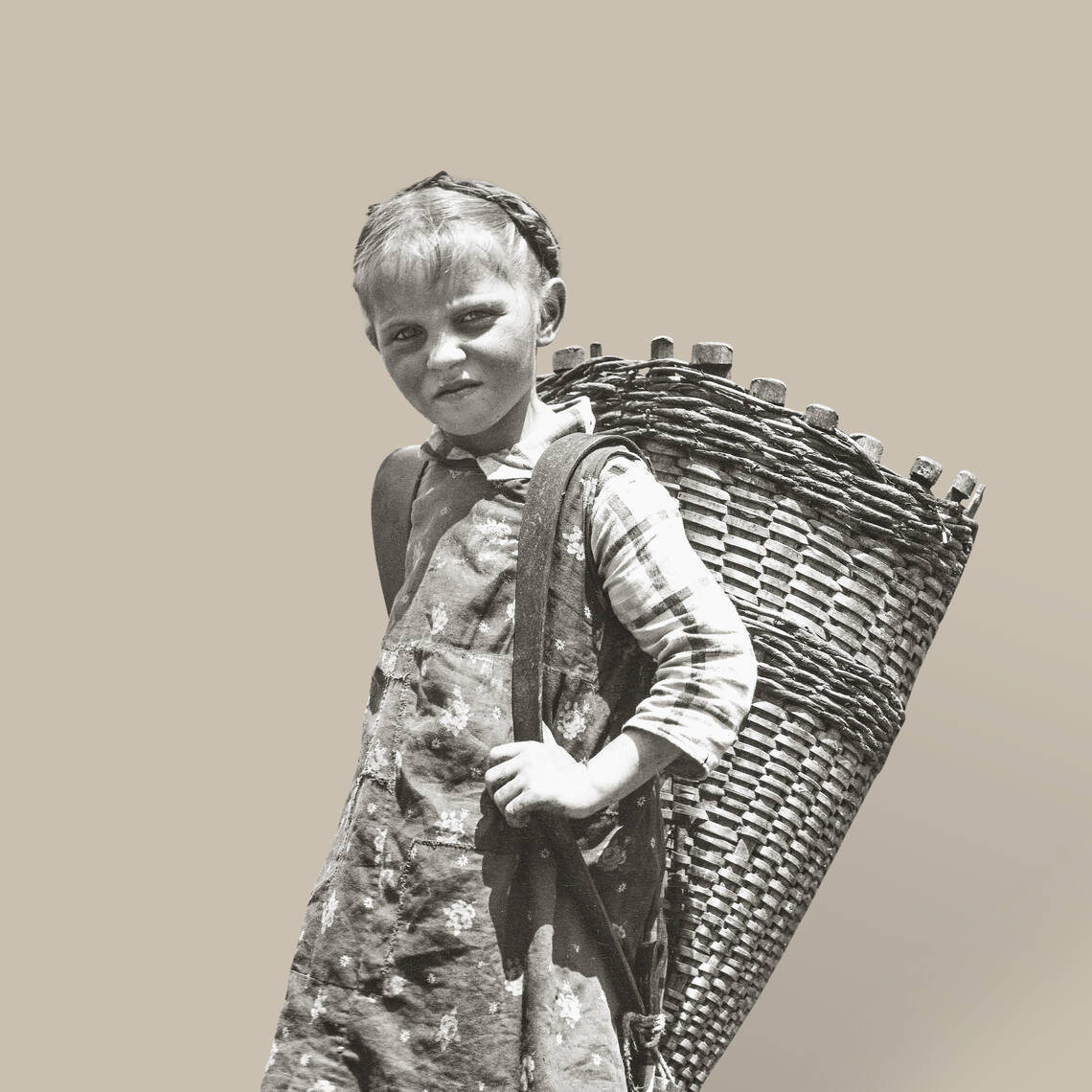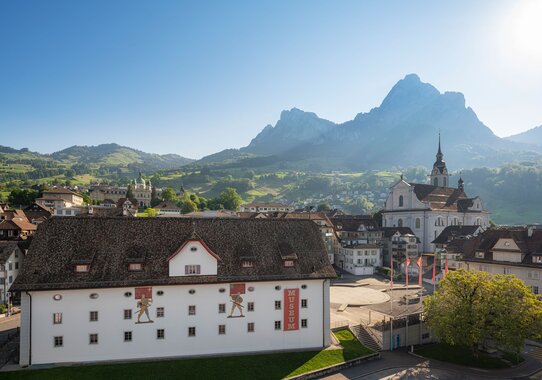accessibility.sr-only.body-term
Making hay, herding cattle, cutting peat, spooling and tatting – children have always supported their families in work, especially in farming. With the rise of industry, children were often exploited as cheap labour, above all in textile mills, and not least in Switzerland. They were forced to work long hours, took on dangerous or unhealthy tasks, and were often prevented from going go to school. Only after the introduction of compulsory schooling in 1874 and the adoption of the Federal Factory Law in 1877, education became a basic human right in Switzerland and children under the age of 14 were prohibited from working.
The exhibition shows many aspects of child labour in those early days and explains how children's rights were regulated in Switzerland. Special attention is given to the conditions in central Switzerland at that time.

Child labour in 19th and 20th centuries
Guided tour for private groups
Guided tour of the exhibition «Child labour in 19th and 20th centuries».
Tour: 1 hour
| Registration: |
2 weeks in advance |
|
|
Duration: |
60 minutes; special packages can be offered on request |
|
|
Group size: |
max. 25 persons per tour |
|
|
Cost: |
CHF 120 for the tour, plus a reduced admission fee of CHF 10 per person. Free entrance for children up to 16 years. |
|
| Opening hours: | Tuesdays - Sundays between 10.00 am – 17.00 pm |
accessibility.sr-only.person_card_info Contact

Child labour in the 19th and 20th centuries
Guided tour of the exhibition "Child labour in the 19th and 20th centuries ".
Guided tours are free of charge for school classes from Switzerland.
Tour: 1 hour
For guided tours and indipendents visits for school groups, please contact us 14 days in advance.
Entrance and guided tours are free of charges for Swiss school classes.
accessibility.sr-only.person_card_info Reservations desk
openinghours.days.long.tuesday Open till openinghours.days.long.wednesday openinghours.and openinghours.days.long.friday openinghours.openfromto.long
Child labour in the 19th and 20th centuries
The new exhibition «Child labour» at the Forum of Swiss History Schwyz deals with a topic that has, up to now, received little attention in Swiss history. It sheds light on how, in the 19th and 20th centuries, children helped to secure their family’s income through their work, and how, over the course of time, legislative measures and compulsory schooling gradually curbed the various forms of labour exploitation.
Children herded cattle, mucked out stables, and lent a hand in haymaking. The made bobbin lace, did spinning, or produced “straw strings” at home. Girls as well as boys have always had to pitch in; they were integrated in the work process from early age on, thus contributing essentially to their family’s existence and wellbeing. In Rothenthurm they helped to harvest ice in winter (called Ischä); in Gersau they worked in the local silk mill, and in Einsiedeln they coloured the pictures of saints.
The new exhibition at the Forum of Swiss History Schwyz sheds light on various aspects of child labour in earlier days and explains what kind of tasks children were asked to perform. For instance, what kind of work did loaders (Lädelibueb) and spreaders (Streicherkind) do? Why were children’s hands so valuable in embroidery? Or, how does one cut peat? The exhibition focuses in particular on the conditions in central Switzerland at the time.
It was only when compulsory schooling was introduced in 1874 and the Swiss Factory Act came into force in 1877 that the children’s situation improved. Elementary education was now a basic right and child labour under the age of 14 forbidden. But particularly in the country’s poorer and more remote regions, people still relied heavily on child labour – or else they were sent to work abroad. The «Swabian kids» from the canton of Grisons along with fostered and contract children who had to work as farm hands as well the so-called «Spazzacamini» from the Ticino, who were sent to Italy to clean chimneys, gained sad notoriety in this regard. The exhibition pays special attention to the fate of these children.
And what’s the situation like today? Switzerland signed up to the UN Convention on the Rights of the Child in 1997. But across the world, roughly 160 million children from the age of five are still forced to work, for instance, on plantations, in factories, and mines.
Waiting for you in the exhibition are a range of historical objects, impressive photographs, documents, media stations as well as statements by contemporary witnesses – you even get the chance to smell certain scents that go with the subject: for example, hay and manure (agriculture), machine oil (factory), cabbage stored in a cellar (cottage industry), and soot (boy chimney sweeps).
At the end of the exhibition, visitors get the chance to recount and record their own experiences or those of their parents or grandparents at a special media station – in other words, their own personal work history.
Images
Press contact Forum of Swiss History Schwyz
- Overall management Denise Tonella
- Project direction Pia Schubiger
- Curators and Concept Pia Schubiger, Rebecca Sanders
- Research associate Maxi Weibel
- Public relations and marketing Karin Freitag-Masa (Leitung), Conny Lüönd
- Cultural Services and Museum Education Isabelle Marcon Lindauer (Leitung), Laura Rompietti
- Scenography Ralph Nicotera
- Exhibition Graphic Clavadetscher Gestaltung für Kultur und Wirtschaft
- Advertising graphic Büro Nord GmbH
- Exhibition construction Marc Hägeli, Roland Reichlin
Alder Stahl und Schweiss, Atelier S&G AG, Moderne Metallbearbeitung GmbH, Luziferro AG, Makro Art AG, Perplex Plus AG, Touchwood GmbH, Utiger Maler AG - Items generously loaned by Laura Mosimann, Claudio Stefanutto, Samira Tanner
- Conservation and mounting of objects Markus Leuthard (Leitung), Jürg Mathys (Projektleitung), Nathalie Ellwanger, Charlotte Maier, Carolin Muschel, Gaby Petrak, Tino Zagermann
- Logistics of objects and montage of objects David Blazquez (Leitung), Christian Affentranger, Simon D'Hollosy, Reto Hegetschweiler, Markus Scherer
- Photography Jörg Brandt, Felix Jungo
- Photographic library Andrea Kunz, Fabian Müller, Remo Sidler
- Lithographs and Scans Georg Sidler
- IT, web, media stations Alex Baur, Thomas Bucher, Ueli Heiniger, Pasquale Pollastro, Danilo Rüttimann, René Vogel
Tweaklab AG Sarah Glauser (Projektleitung), Hanspeter Giuliani, Dominik Schläpfer, Kaspar Hochuli - Translations Marie-Claude Buch-Chalayer
Giovanna Planzi
Nigel Stephenson - Copy-editing Apostroph Luzern AG
- With the support of
Albert Müller, Zug
Givaudan Suisse SA, Kemptthal
Università della Svizzera italiana, L’ideatorio / Science et Cité
- Archivio di Stato del Cantone Ticino, Bellinzona
- Bezirksarchiv Gersau
- Hannes Binder, Zürich
- MarieLies Birchler, Zürich
- Camenzind + Co. AG, Gersau
- Cinémathèque suisse
- Comptoir Daniel Jenny & Cie., Ennenda
- Nadine Felix, Wädenswil
- Fotostiftung Schweiz
- FFV, Kunstmuseum Bern, Dep. GKS
- Luigino Gamboni, Gordola
- Gemeinde Schwyz
- Historisches Museum Thurgau
- Franz Kälin, Magenta Film Einsiedeln
- Kloster Einsiedeln, Bibliothek und Kunstsammlung
- Komitee für UNICEF Schweiz und Liechtenstein
- Albert Marty-Gisler, Rothenthurm
- Museo di Val Verzasca, Sonogno
- Museum Fram, Einsiedeln
- Ortsmuseum Gersau
- Gabriela Pereira, Biel
- Pinacoteca cantonale Giovanni Züst, Rancate (Mendrisio)
- Privatsammlung, Solothurn
- Saurer Museum Arbon
- Schweizerisches Bundesarchiv, Bern
- Schweizerisches Institut für Kinder- und Jugendmedien, Zürich
- Schweizerische Nationalbibliothek, Bern
- Schweizerisches Sozialarchiv, Zürich
- Schweizer Strohmuseum, Wohlen
- Staatsarchiv des Kantons Schwyz
- Staatsarchiv des Kantons Zürich
- Staatsarchiv Kanton St. Gallen
- Staatsarchiv Luzern, Archiv von Moos
- Staatsarchiv Zug
- Stadtarchiv Ravensburg
- Stiftung Kinderdorf Pestalozzi, Trogen
- Sust Museum Horgen
- Tal- und Sagenmuseum Lauterbrunnen
- Verein Gesichter der Erinnerung
- Victorinox AG, Ibach-Schwyz
- Winterthurer Bibliotheken, Sammlung Winterthur
- Zentralbibliothek Zürich


